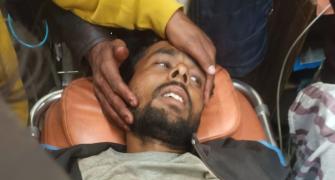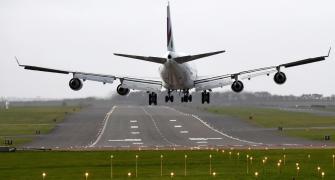Six weeks ago, the tsunami devastated Tamil Nadu, killing thousands of people and leaving many thousands more without families, homes and livelihood. rediff.com correspondents travel to the districts most affected by the catastrophe to find out how the administration is coping with the aftermath and how the survivors are rebuilding their lives. An ongoing series:


I am at the Nagapattinam district collectorate, which has a huge campus. Its car park is full. A non-governmental organisation's coordination centre is on the right, where activists discuss plans, while local volunteers wait to assist them.
Nagapattinam was the worst affected district in Tamil Nadu, with more than 6,000 people killed in the tsunami tragedy.
On the ground floor of the collectorate, the first thing I notice on the left is a cradle, part of the chief minister's cradle baby scheme. This is for those who don't want their baby girl so they can leave it in the cradle and go away. No questions asked, the state looks after it. The measure is to ensure people do not kill the girl children, a common practice in some districts in Tamil Nadu.
The cradle baby scheme, which has helped halt the cruel act, was Chief Minister J Jayalalithaa's brainchild. Amma, as she is known, has lived up to the title.
A board at the collectorate shows how many people have died in the district in the tsunami tragedy, how many villages have been affected and other related facts.
I take the corridor on the left, which starts with Public Relations Officer Kannadasan's office. Tired but helpful, he suggests I meet the district revenue officer and the additional collector, both handling relief, before the collector.
Tsunami aftermath: Return to life
On the right side is a medical camp manned by a doctor and two nurses. The doctor informs me the camp is for people with petitions for the collector.
Also by Ganesh Nadar: A story of true grit from Colachel
I go down the right corridor, which ends with District Social Welfare Officer Surya Kala's office. There are parents with children, who want to leave them in the state orphanage. Two nuns from a convent in Tranquebar want to look after the children.
As the staff sit on the office floor and eat, Kala walks in, busy on her cell phone.
She divides the kids into two groups and keeps two of her staff members to take charge. One group she sends to the adolescents home, the other to the orphanage.
She says she has 99 orphans; now the number will be 104. The parents who had come are happy. A girl who had studied up to 12th standard wants a job.
On the first floor, the hall is crowded. It is Public Grievances Day. People queue up to petition Collector J Radhakrishnan.
He is seated, with a small table in front, as he reads the petitions. He asks questions before directing the complainant to the official concerned.
While that is on, his cell phone rings. He comes out of the hall to take the call, as it is noisy inside and reception is poor. His personal security guard follows him, perhaps to ensure nobody, including pesky journalists like me, come near him.
After the call is over, he tells me he is busy but I can see him later in the evening.
ALSO SEE: How women power built Paddukuppam
The district revenue officer for relief has the information I want, on charts in his office. An interesting quote on his door says 'DON'T say it's not my JOB.'
I return at 4:30 pm, but the collector is away. He is delayed as a body has been found in the post-tsunami debris. Bodies are still being found even weeks after the tsunami struck.
I am told to return at 7:30 pm.
When I return, the car park is full of government vehicles. A meeting is on but the NGO coordinating centre is enveloped in darkness. The officials have not gone home, they are seated in the dark, busy discussing relief efforts.
When they have to read anything, they switch on their cell phones. They are seated in the dark, as unlike the others at the collectorate, the mosquitoes are not friendly.
In the waiting room, I meet Sairam, who is with an NGO. He goes to villages no one has gone to. He had with him van drivers who have no work. Their vans used to transport fish, but now there is no fish.
The fishermen got relief, but not the drivers.
Collector Radhakrishnan promises to help them.
The collector finishes one meeting and tells me to wait in his chamber. The army personnel are leaving, and he has to see them off.
He talks to me for sometime, but soon has to address a sub-collectors meeting. He returns to finish the interview. It is almost 10 pm when we are done.
The collector continues to work into the night. The lights burn bright at the collectorate. A light of hope for people devastated by the tsunami.
Complete coverage: The tsunami destruction
Photographs: Paresh Gandhi/India Abroad
Image: Rahil Shaikh








